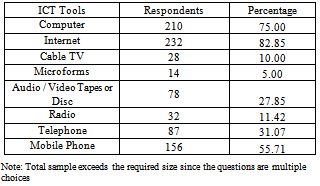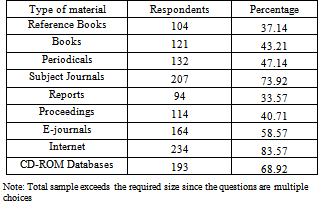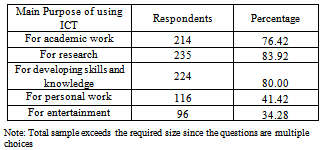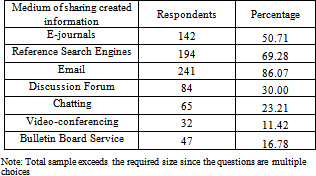S. Thanuskodi
Associate Professor and Head i/c Department of Library & Information Science Alagappa University, 630 003, Karaikudi
Correspondence to: S. Thanuskodi , Associate Professor and Head i/c Department of Library & Information Science Alagappa University, 630 003, Karaikudi.
| Email: |  |
Copyright © 2012 Scientific & Academic Publishing. All Rights Reserved.
Abstract
This paper deals with use of ICT for information creation by faculty of Annamalai University, i.e. type, frequency, duration, purpose of ICT material used, frequency of library visit, average time spend in the library contribution of ICT of creating information and ranked performance, use and importance of ICT for information creation. The results show that 75.71 % of respondents used ICT tools as a source for relevant materials for creating new information. The study found that most of them 83.92 % prefer for research followed by 80 % of respondents used developing skills and knowledge. The paper highlighted that the information about frequency of library visit for creating information from where it can be analyzed that 34.28 % of the respondents visit library once in three days and 25.71 % of respondents visit daily.
Keywords:
Academic Library, Information & Communication Technology (ICT), Internet, CD-ROM Databases, E-journals
Cite this paper:
S. Thanuskodi , "Use of ICT for Information Creation among Faculty Members of Annamalai University, Tamil Nadu, India", International Journal of Library Science, Vol. 1 No. 4, 2012, pp. 61-65. doi: 10.5923/j.library.20120104.03.
1. Introduction
The story of civilization indicates that libraries have been an essential part of civilized society. These came into being to serve the needs of the society. Their form, character, purpose, functions and services have been determined by the needs of the society served by it. The libraries played an important part in the social, political, economic and cultural development of the society. These have a significant role in the preservation and advancement of culture; formal and self education; and reading material and other documents to handicapped readers to alleviate their miseries; assisted disadvantage numbers of society to gain rightful place in society; helped businessmen to improve their business; assisted decision makers, researches, students and other members of society in achieving their goals. The modern trend of education is to develop a thinking individual who should prove to be a self reliant person in every walk of life. Such a kind of thinking individual can be created only if he is initiated into the channels, which lead him in right directions for proper development of his mind. This can be achieved by wide reading which is sure to lead him to form his independent judgment of the problems facing him. “A library is the key to the knowledge of the world and a librarian is properly called the matchmaker of the beautiful bride – the book and the curious bridegroom the reader.”Information and Communication Technology has revolutionized the concept of libraries. IT has almost converted the world into a global village. Libraries are also changing to meet the demand put on them. The new generation whose demand for information is never met is always demanding that traditional libraries should be developed as a well equipped and interconnected as computerized libraries. An automated library is one where a computer system is used to manage one or several of the library’s key functions such as acquisitions, Circulation, Cataloguing, Serials control and the online public access catalogue. Today we see most of our libraries either fully computerized or partially computerized.
2. ICT in Education
Never before was information so readily available at the press of a button, the Internet has changed the way the world behaves, does business, and thinks. Even school children search the web for study material to support their homework. Today, academicians do not need to spend much time on library research poring over bulky tomes and taking copious notes. They have the facility of faster and surer access to a much wider range of information through the Internet, not just to read but to print or save or forward to others as might suit their purpose. . Internet research has come to be recognized as an essential study tool in all higher education courses in developed countries. The Internet has also played a major role in streamlining administrative procedures and processes of universities worldwide. Any modern university, management school or institute today has its own website on which courses offered are listed. Students apply for admission on-line which reduces paperwork and increases administrative efficiency. They receive e-notifications regarding admission, course schedules, and billing procedures, which they can pay on-line, as well as their results. Teachers prefer to receive tutorials on-line, which not only lends itself to faster transmission, but also avoids the difficulty in reading a manuscript. Similarly, some teachers not only put up their course material on the web-site, but also their lectures, which can be heard on-line such that students who were unable to attend can also benefit from them. The faculty and students remain connected through email on which students receive instructions, send essays/assignments, fix appointments, etc. All students are expected to have their own laptop or notebook computer.While a traditional Western university still has face-to-face lectures, it also offers on-line courses especially during the summer break. While such courses have the obvious disadvantage of the absence of personal interaction, they allow for discussion through setting up of chat rooms. Such on-line courses and discussions have often proved to be more rewarding than regular classroom interactions as they allow for students and teachers from different parts of the world to converge. On-line Universities, which do not require physical infrastructure, have facilitated greater accessibility to education than ever before.. While popular perception values a degree from a regular college over one from an On-line college, the greatest advantage of an on-line university or college, that a student need not commute or live on campus tilts much of the debate in its favour.. This is especially true for certain kinds of courses designed to cater to the needs of students who do not have financial backup or family support. As acquiring specialized degrees is directly related to to better jobs, re-engineering e-education at tertiary level has a great advantage. As jobs become more and more insecure and mid-life career changes more frequent, the need for on-line education is increasing overtime.
3. Literature Review
A study in 2008 by Alshankity and Alshawi examined the gender differences in Internet usage among faculty members in Saudi Arabia. The study collected information from 504 faculty members in four Saudi Arabian higher education institutions regarding Internet usage for academic purposes. In the context of the gender-segregated higher education systems and the relatively new advent of Internet in the region, the researchers did not see a significant gender difference in the overall Internet usage[1].In 2006, Al-Ansari conducted a study on internet use by the faculty members of Kuwait University. This study was designed to investigate the patterns of Internet use by the faculty including purposes for use, its impact on teaching and research, Internet resources used, and the problems faced while using the Internet. A structured questionnaire was used to collect data from the faculty coming from four colleges of Kuwait University, i.e. Arts, Social Sciences, Sciences, and Engineering. The study revealed that the Internet is mostly used for communication, research, and publication by saving time, find up to date information, and cooperate with their colleagues. Slow speed, lack of time, and lack of access from home are the major problems[2].Aldojan (2006) investigated the Internet use among Education faculty members in Jordanian Public Universities. The population of this study included the entire education faculty members (309) in seven Jordanian public universities, ranking instructor/lecturer, assistant, associate, and full professors. The study explored how often, what types of Internet tool is used on a daily basis, and the degree of satisfaction of education faculty members in Jordanian public universities using the Internet in their academic work. The purpose of this study was to collect and to analyze the data to determine the patterns of Internet use and to identify the faculty's concerns and their overall satisfaction degree of its services[3].Gifty Adika (2003) analysed Internet use among faculty members of universities in Ghana. Research results show that in spite of the benefits of the Internet, its use among faculty is still very low. The main reasons for this are lack of access to the Internet and the need for training. It suggested that university authorities must take immediate steps to provide general access points for faculty through computer laboratories. Here librarians, information professionals and computer scientists have vital role to play for organising training and refresher sessions for faculty to get up to date information via Internet for teaching and research[4].A doctoral study by Fortin (2000) explored faculty members' use of and their information seeking behaviors and activities on the Internet at Angelo State University. Using both a quantitative and qualitative methodology, differences were found between tenured and tenure track faculty members on the perceived value of the Internet to meet their research and classroom information needs. Similar differences were also found among faculty members in the broad discipline areas of the humanities, social sciences, and sciences. Tenure-track faculty members reported a higher average Internet use per week than tenured faculty members[5].
4. Scope of the Study
The scope of the present study entities use of ICT for information creation by teachers has been limited only to the teachers of various departments of Annamalai University, India.
5. Objective of the Study
● To study the use and importance of information communication technology for information creation ● To study various resources of Information and communication technology● To determine the role of resources of Information and communication technology for information creation.● To find out ICT base tools and devices used by the faculty members.
6. Methodology
The study used a questionnaire, with 15 questions spread over the following areas General profile of the respondent, Attitude towards ICT, Use of ICT, ICT skill of faculty members. To facilitate quantification and analysis of data, mainly close-ended questions were used along with checklists and rating scales. To capture a response and to have fewer missing responses, options such as “no opinion”, “don't know”, and “don't know about it” are also included. A random sample of 300 faculty members of Annamalai University, was selected and questionnaires were distributed among them. Of those, 280 (93.33%) questionnaires were returned completed.
7. Data Analysis and Discussion
Analysis of data is the ultimate step in research process. It is the link between raw data and significant results leading to conclusions. This process of analysis has to be result oriented.| Table 1. Faculty wise Distribution of Respondents |
| | Name of the Faculty | No. of Respondents | Percentage | | Science | 97 | 34.64 | | Arts | 183 | 65.36 | | Total | 280 | 100.00 |
|
|
A study of data in table-1 indicates the faculty wise distribution of respondents. It could be noted that out of the total 280 respondents, 65.36 per cent of them are arts faculty members and 34.64 per cent of them are science faculty members. It is concluded that more arts faculty members followed by Science faculty members are the respondents in the study.| Table 2. Gender wise Distribution of Respondents |
| | Gender | No. of Respondents | Percentage | | Male | 227 | 81.07 | | Female | 53 | 18.93 | | Total | 280 | 100.00 |
|
|
A study of data in table-2 indicates the gender distribution of respondents. It could be noted that out of the total 280 respondents, Majority of the respondents (81.07%) belong to the male group and the rest of them (18.93%) are females.
7.1. ICT Tools for Information Search
Table-3, depicts the use of ICT tools for information search by the teachers. Out of 280 respondents, the most of the respondents prefer to the Internet and computers i.e. 82.85 % and 75 % respectively for information search and the they prefer to Mobile phone 55.71 %, Telephone 31.07 %, Audio/Video Tapes and Discs 27.85%. Very few respondents use Radio, Cable TV, and Microforms respectively. Table 3. Use of ICT tools for information search
 |
| |
|
Table 4. Use of ICT Tools
 |
| |
|
It can be analyzed that out of 280 respondents, 212 respondents i.e. 75.71 % used ICT tools as a source for relevant materials for creating new information. Following to it, there are 62.85 % respondents used it for generating new data and store and retrieve data i.e. 51.07 % and respondents 34.28 % used ICT tools for processing data in the process of information creation.Table 5. Type of material used by Faculty Members
 |
| |
|
Table-5 shows the type of material used by faculty members. It is observed that, out of 280 respondents 83.57 %, 73.92 % and 68.92 % respondents preferred to Internet, subject journals and CD-ROM Databases respectively followed by 58.57 % respondents used E-journals, 47.14 % respondents used periodicals, 43.21 % respondents used books, 40.71 % respondents used proceedings and only 37.14 % respondents used reference books respectively.
7.2. Frequency of Using ICT
| Table 6. Duration for using ICT Tools and Devices |
| | Duration for using ICT Tools | Respondents | Percentage | | Less than 1hour | 82 | 29.28 | | 1 to 2 hours | 126 | 45.00 | | 2 to 3 hours | 40 | 14.29 | | More than above | 32 | 11.43 | | Total | 280 | 100.00 |
|
|
Table-6, shows the frequency of using ICT tools and devices for information creation by faculty members of Annamalai University. Out of 280 respondents, 45 % of respondents used ICT tools 1 to 2 hours. Then 29.28 % used ICT tools and devices less than 1 hour. 14.29 % and 11.43 % of respondents used ICT tools and devices 2 to 3 hours and more than above respectively.
7.3. Purpose of Using ICT
Table 7. Purpose of using ICT
 |
| |
|
Table-7, shows the purpose of using ICT for information creation by faculty members in preference. Out of 280 respondents, most of them 83.92 % prefer for research followed by 80 % respondents used developing skills and knowledge, 76.42 % respondents used for academic work, 41.42 % used for personal work and 34.28 % used for entertainment. Table 8. Medium of sharing created information through the use of ICT
 |
| |
|
Table-8, shows the preferences given by the respondents for medium of sharing created information through the use of ICT, where it can be seen that 86.07 % prefer to E-mail, 69.28 % to reference search engines and 50.71 % to E-journals followed by discussion forum, chatting, Bulletin Board Service and video-conferencing.
7.4. Library Visits
| Table 9. Frequency of Library Visit for creating new information |
| | Frequency of visit | Respondents | Percentage | | Daily | 72 | 25.71 | | Once in three days | 96 | 34.28 | | Weekly | 48 | 17.14 | | Monthly | 40 | 14.28 | | Occasionally | 24 | 8.57 | | Total | 280 | 100.00 |
|
|
Table-9, highlights the information about frequency of library visit for creating information from where it can be analyzed that 34.28 % of the respondents visit library once in three days and 25.71 % of respondents visit daily. Following to it 17.14 % and 14.28 % of the respondents visit weekly and monthly respectively. A few of the respondents 8.57 % visit occasionally.
7.5. Library Effectiveness
| Table 10. Availability of Library and Information resources presently with satisfaction |
| | Library and Information Resources | Respondents | Percentage | | Adequate | 92 | 32.86 | | Partially Adequate | 154 | 55.00 | | Inadequate | 22 | 7.86 | | No opinion | 12 | 4.28 | | Total | 280 | 100.00 |
|
|
Table-10 highlights information about the satisfaction with library and information resources presently available. Out of 280 respondents, 55 % of them says that the library are partially adequate followed by 32.86 % of them says the library are adequate. 7.86 % and 4.28 % of respondents says the library and information resources are inadequate and no opinion respectively.
8. Conclusions
With the advancement of the Information and communication Technology, nowadays the education systems are on the stage of revolutionary change. Creation of information has now become more obvious and necessary because of fragility of digital platforms becoming soon obsolete. It is more relevant because owned digital documents and information are apparent and virtual than its physical form and for guarantying future use is necessary. Creating information and converting it into printed form, as well into digital form is boon today because of information and communication technology. Here the researcher has made through efforts to study the use and importance of ICT for information creating. It is found from the study that all the faculty members in the various departments know about the information and communication technology and also they agreed for its use and implementation for the progress of the university. It can be concluded that ICT plays an important role to create new information and knowledge with saving time of the users. The transmission of information has become very easy with the ICT tools and devices.
References
| [1] | Alshankity, Z., and Alshawi, A. (2008).―Gender differences in Internet usage among faculty members: The case of Saudi Arabia. This paper appears in: Human System Interactions, 2008 Conference. |
| [2] | Husain Al-Ansari (2006).―Internet use by the faculty members of Kuwait University. The Electronic Library, Volume: 24 Issue: 6 pp. 791 – 803. |
| [3] | Aldojan, M. (2006). ―Internet Use among Education Faculty Members in Jordanian Public Universities. In E. Pearson & P. Bohman (Eds.), Proceedings of World Conference on Educational Multimedia, Hypermedia andTelecommunications 2006 (pp. 13-18). Chesapeake, VA: AACE. |
| [4] | Gifty Adika (2003). Internet use among faculty members of universities in Ghana. Library Review, Volume: 52 Issue: 1, pp. 29-37. |
| [5] | Fortin, Maurice G. (2000). Faculty use of the World Wide Web: Modeling information seeking behavior in a digital environment, PhD thesis, University of North Texas, Denton, Texas. http://digital.library.unt.edu/permalink/meta-dc-2723 |

 Abstract
Abstract Reference
Reference Full-Text PDF
Full-Text PDF Full-Text HTML
Full-Text HTML



